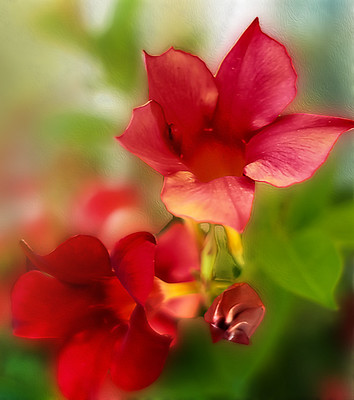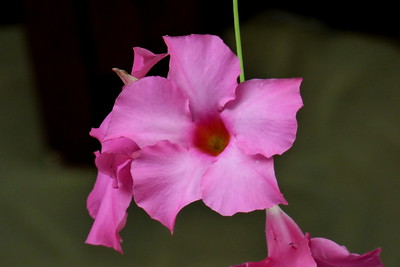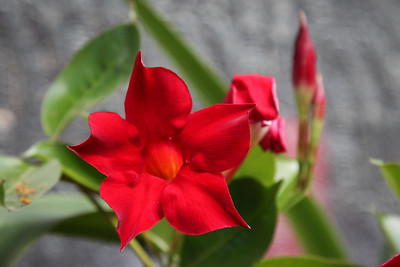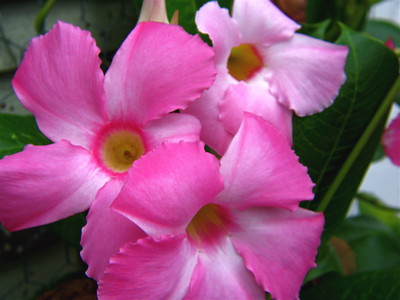A Dipladenia Plant Care Guide to Having Gorgeous Trips: By botanical name, the plant is called Mandevilla spp. It’s more commonly known as “dipladenia”. Other popular names include “Mand-a-villa” and “mandevilla vine”. There are some 200 species of dipladenias.
A few select varieties are used for indoor decorative purposes by florists, nurseries and garden centers. Those plants would be only a handful that you see at home improvement stores or big box chains like Home Depot or Lowes. There are hundreds of other varieties out there all classified within the same family (Apocynaceae). Most of them can stand up to colder climates, but most of those plants you’d find in nurseries will be tropical for your indoor needs.
Mandevilla flowers bloom on new growth and it’s one reason the plants need to be pruned occasionally after flowering has ended. If you’re not familiar with dieffenbachia plants (another popular houseplant), they too produce new growth from last year’s old vine and old stems.
Table of Contents
Dipladenia Plant Information
When the plant is done blooming, simply cut back or pinch off any dead flowers and thin out some of the older stems as well if you think it’s getting too thick for its own good. Sometimes we let them grow a little long before we cut them back just so we can see how it will turn visually with that cutback. We may also do a heavy pruning over the winter months when they are not blooming to keep them from getting too leggy from lack of light.
In the fall, look for new growth to begin in earnest. New shoots come up and even if you don’t see it at first, your plant is most likely already putting out a vine or two that will grow long enough to hold itself up by summertime. Because we live in zone 9, we can enjoy our dipladenia indoors with us all year round. Out here they bloom freely until about November when it gets too cold and seek refuge inside again during midwinter where they continue their cycle of growth and flowering – on and off all year long depending upon its exposure outside.
How Much Light Dipladenia Plant Needs?
- LIGHT: A dipladenia plant needs lots of light. They need full sun to partial sun exposure for 6-8 hours per day.
- Newer hybrids are more forgiving on the amount of sunlight they can get away with, but it will still affect their growth and flowering pattern.
- You’ll see them grow faster in spring or summer when you give them ample light all day long.

How Much Temperature Dipladenia Plant Needs?
- TEMPERATURE: 55° – 90° is ideal indoors without exception. Anything below this slows down their growth pattern dramatically where nothing much will happen until temps rise back up again into that zone.
- Cold drafts from open doors or windows will also do some damage if they sit right next to a drafty area for any length of time.
How Much Water Dipladenia Plant Needs?
- WATER: Watering is a love-hate thing with dipladenia plant care.
- For those who have kept them as houseplants, they tend to be more finicky about wet, soggy soil that stays moist all the time as opposed to dry soil that gets soaked once every week or so for an hour or two.
- In nature, they can take long periods of little or no rainfall and remain dormant until conditions improve.
- If you wish to keep your plant going through these “droughts” simply water it less frequently – a trick we use here in zone 9 where we go weeks without rain during certain times of the year which would normally kill any other plant out there.
- It’s also what I attribute to the growth of these plants indoors as everyone here, myself included, waters their plants on a schedule.
- In nature it rains and they soak up moisture from duff on the forest floor where their roots go down deep to find moisture even during those dry spells.
- It’s what I’ve been trying to emulate indoors by keeping my container plant at 70% – 80% humidity.
Potting Mix
- POTTING MIX: A good mix is a must for success with growing dipladenias inside. They hate being too wet or too dry but don’t let that “soggy soil” myth fool you into thinking they will croak if soil remains moist all the time either.
- If your potted plant isn’t looking so great after several months or a year, you can easily revive it by changing out the soil for a new mix.
- Cold weather is the only thing that will kill them if their roots stay too wet or sit in a cold draft all winter long.

How to grow Holly Leaf Begonia: Care, Benefits, Growth, Characteristics
Fertilizing
- FERTILIZING: Feeding your plant once every other month during its growing season (spring and summer) is recommended to help keep it looking good indoors.
- A balanced 20-20-20 fertilizer mixed at half strength.
- You could also use Peters 20-20-20 or Miracle Grow, etc.
- Just avoid fertilizing when they are not blooming because this stimulates growth which can actually delay buds from setting on flowers if done too often throughout the year.
- Once flowering has ended, switching over to bloom formula will promote more blooms next year.
Repotting
- REPOTTING: Repotting is only necessary every 2-3 years where you want to refresh the potting soil entirely, let it dry out completely for about a week or two until it becomes quite dry before re-potting into fresh, new soil.
- If your plant is outdoors during spring and summer months (zone 9+) they can get root bound after a few years as well which will slow down their growth pattern.
- If this starts to occur outdoors in zone 9+, I recommend repotting into a larger container to keep up with its growing needs at bay.
Flowers
- FLOWERS: The flowers should last several weeks indoors and can continue on if conditions are right.
- The amount of sunlight and humidity in their growing area will affect the flower production once they reach flowering size.
- Outdoor plants will produce more blooms than plants grown indoors but you can get them to re-bloom next summer by cutting off spent flowers and giving it a couple of week break from any fertilizer during that time.
Insects
- INSECTS: Insects will only affect your plant if conditions are right – wet soil, staying too moist for long periods (a breeding ground) and/or not enough fresh air circulation around the entire plant, especially at night where bugs like mites or aphids might be attracted to the moisture on the underside of leaves.
- Keep an eye out for these offending pests or signs of them being there on dipladenia plants so you can take the appropriate action if needed.

What Does A Botanist Do: Learn About Careers In Plant Science
Growing a Dipladenia Plant Indoor
This plant performs best at temperatures between 70 and 80 degrees Fahrenheit. To get the most out of your succulent, keep night temperatures at about 65 to 70 F (18-21 C).
The soil should be well drained. A succulent plant mix works great. We use a blend of 3 parts potting soil and 1 part sand. These plants like to dry out between each watering, do not let them sit in water as they will just rot.
Fertilize with a balanced 20-20-20 fertilizer once every two weeks or so during the growing season (spring and summer). Or you could use Peters 20-20-20, Miracle Grow etc. During dormancy, fertilizing is usually not necessary but can be used if desired. PH level should remain around 6.5 – 7.0.
After flowering cut spent flowers down to encourage more blooms next year by allowing plant to go dormant. Cut the leaves in half to encourage a bushier growth habit.
The plant can be divided after flowering by carefully cutting it in half and setting the cuttings in a new pot with moist soil. The best time for division is spring or early summer (or anytime if you are growing them outdoors).
If the plants get rootbound after 2-3 years this might stimulate more blooms as well since they should not be too far gone.. Indoor plants tend to die back at the end of winter until warmer temperatures appear while outdoor plants will rest during cooler weather (winter) and rebloom each summer again, but indoor plants may need to be repotted yearly into fresh soil springtime if they start looking like they are dying and/or growing very little.
Even though this plant has a reputation for being easy to grow, it can be attacked by garden pests such as aphids and whiteflies if there is something to attract them around them such as extra moisture or poor soil drainage so prevention is the key here!
This plant is an epiphyte which means it grows on another plant (ooh la la) meaning it likes its roots exposed to the air so do not cover the root zone with any type of mulch. Keep in mind that dipladenia plants like high humidity levels and good air circulation at night around their entire plant while still keeping up with proper watering during warm months while avoiding wet conditions under leaves for too long.

Picking Strawberry Fruit: When And How To Harvest A Strawberry
Let dry out between waterings and avoid sitting in saucers of standing water to help prevent root diseases/fungi. These plants are NOT mean to be watered on a schedule (like once or twice a week) but instead should be watered whenever they start to feel dry like your average houseplant.
Container plants will continue to get larger and bushier over time. If you want your container plant to stay more compact (in 4″ pot), pinch back new growth by hand or use pruning shears. Pinching is done by using thumb and index finger to grasp stem between 1/4 and 3/4 down from top and then simply pinching up until you feel the branch snap off (make sure not to go too high on stem).
You can take stem cuttings anytime to propagate if the plant starts looking a little wild and overgrown or too scraggly. Just stick a cutting in moist soil and wait for it to sprout roots.
Sometimes this takes a few months, but an offset will form from where you took cuttings from. Once you have 2 good sized leaves growing from your new plant/offspring then just pop the offspring out of its pot into another pot that has fresh soil mixed with perlite or sand/pebbles if desired, water well and put in sunny window until established (approx 1-2 weeks). Then gradually expose new plants to more light once they are rooted order prevent sun burn.
